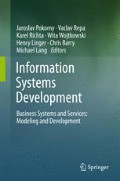Abstract
Services play an increasingly important role in most industry sectors, including IT. Recent emergence of Cloud Computing and the general acceptance of different forms of outsourcing as a mechanism for increasing effectiveness of organizations necessitate a revision of basic SOA concepts to take account of extensive use of externally provided services. A key pre-requisite for this revised SOA architectural framework is the unification of service definitions so that different types of services can be treated in a consistent manner. The unified service definition needs to contain attributes of internally and externally provided services as well as attributes of business and IT services and be customizable to allow its application in different usage scenarios. In this paper we discuss the concept of a service as interpreted in both business and computing literature and propose a concise service definition based on a set of attributes that can be specialized for a particular service delivery scenario. We illustrate using a simple example how such service definition can be used to construct instances of services.
Access this chapter
Tax calculation will be finalised at checkout
Purchases are for personal use only
References
Sholler D (2008) 2008 SOA user survey: adoption trends and characteristics. Gartner, 2008:32 (26 Sept 2008)
Armbrust M et al (2010) A view of cloud computing. Commun ACM 53(4):50–58, ISSN 0001-0782
Tame S (2008) Implementing IT and SOA into the Jetstar business. In: SOA 2008 IQPC conference, Sydney, Australia
Vorisek J, Feuerlicht G (2006) Trends in the delivery and utilization of enterprise ICT. In: Proceedings of 17th annual IRMA international conference, Washington DC, USA, 21–24 May 2006
Peppard J, Ward J (2004) Beyond strategic information systems: towards an IS capability. J Strategic Inf Syst 13(2):167–194
Langenberg K, Wegmann A (2004) Enterprise architecture: what aspects is current research targeting. In: EFPL Technical report IC/2004/77, Ecole Polytechnique Federale de Laussane
OGC (2007) The introduction to the ITIL service lifecycle: Office of Government Commerce (official introduction). The Stationery Office, London, p 238. ISBN 978-0-11-331061-6
Brand K, Boonen H (2008) IT governance based on CobiT 4.1—a management guide. Centraal Boekhuis, Culemborg. ISBN 9087531168
Arsanjani A et al (2008) SOMA: a method for developing service-oriented solutions. IBM Syst J 47(3):377–396
Van Bon J, de Jong A (2007) IT service management: an introduction based on ISO 20000 and ITIL V3. Van Haren Publishing, Norwich. ISBN 9789087530518
O’Neill P, Krauss D (2006) Topic overview: IT service management. Forrester Research, Cambridge
Voříšek J (2008) Principles and models for the management of enterprise ICT. Oeconomica, Praha. ISBN 978-80-245-1440-6
Hefley B, Murphy W (2008) Service science, management and engineering: education for the 21st century. Springer, Heidelberg. ISBN 978-0-387-76577-8
Macaulay L, Zhao L (2008) SSME at Manchester: bringing people, business and technology together. In: IBM SSME summit: education for the 21st century, New York
Haas H, Brown A (2004) Web services glossary, W3C working group note. World Wide Web Consortium (W3C), MIT/CSAIL, Cambridge
Christensen E et al (2001) Web services description language (WSDL) 1.1. http://www.w3.org/TR/wsdl. Accessed 10 Mar 2010
Web Services Activities (2010) http://www.w3.org/2002/ws/. Accessed 10 Mar 2010
Quartel DAC et al (2007) COSMO: a conceptual framework for service modelling and refinement. Inf Syst Frontiers 9(2):225–244
O’Sullivan J, Edmond D, ter Hofstede AHM (2003) Service description: a survey of the general nature of services. Technical report FIT-TR-2003-02, Queensland University of Technology, Brisbane
Alter S (2008) Service system fundamentals: work system, value chain, and life cycle. IBM Syst J 47(1):71–86. ISSN 00188670
Acknowledgments
This research was supported by IGA (Internal Grant Agency) grant No. F4/1/2010, GAČR (Grant Agency, Czech Republic) grant No. P403-10-0092, and the Research Centre for Human Centered Technology Design at the University of Technology, Sydney.
Author information
Authors and Affiliations
Corresponding author
Editor information
Editors and Affiliations
Rights and permissions
Copyright information
© 2011 Springer Science+Business Media, LLC
About this paper
Cite this paper
Feuerlicht, G., Burkon, L. (2011). Towards a Unified Service Definition. In: Pokorny, J., et al. Information Systems Development. Springer, New York, NY. https://doi.org/10.1007/978-1-4419-9790-6_18
Download citation
DOI: https://doi.org/10.1007/978-1-4419-9790-6_18
Published:
Publisher Name: Springer, New York, NY
Print ISBN: 978-1-4419-9645-9
Online ISBN: 978-1-4419-9790-6
eBook Packages: Computer ScienceComputer Science (R0)

